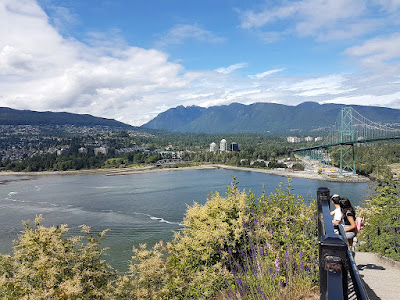CAN: Stanley Park (Part 2)
Stanley Park Causeway, Vancouver, British Columbia, Canada





































Let's continue with the second part of Stanley Park, which is one of the major attractions of Vancouver. The 405-hectare park is about one-fifth larger than the 340-hectare Central Park of New York, the USA and close to half the size of the 960-hectare Richmond Park of London, the UK.

---
CAN: Stanley Park (Part 2) <YOU ARE HERE!>
---
After admiring the totem poles, my BFF and I continued walking northwest, encountering a bronze statue of a girl in a wetsuit by Elek Imredy, a Hungarian sculpture who emigrated to Canada in 1957.

Next, we saw the colourful fibreglass replica of the figurehead of S.S. Empress of Japan, which used to cross the Pacific Ocean over 400 times.


 |
| The original restored figurehead is placed in Vancouver Maritime Museum. |
You can do water fight at the park.


Lions Gate Bridge still seemed so far away, but we'd want to have a closer look at it.

However, instead of walking along the seawall further, we decided to take some of the trekking routes.
 |
| Ravine Trail is wheelchair-accessible. |


The trail brought us to Beaver Lake, which is a shrinking lake that's expected to become a swamp in less than 50 years at the point of writing.


 |
| The lake is shrinking at a fast rate due to the abundance of water lilies. |
We really enjoyed the serene atmosphere surrounding the various trails.


 |
| I tried counting the rings, but I gave up in the end. |


 |
| We finally found the way out to Stanley Park Drive. |
Lions Gate Bridge gets its name from The Lions, a pair of mountain peaks north of Vancouver. The total length of the bridge is 1,823 m.

Prospect Point marks the northern tip of Stanley Park. There's a building that houses a gift shop, a café and a restaurant.


 |
| Pure maple syrup, anyone? |
We had a late lunch at the restaurant there.


After lunch, we indulged in the view from the lookout point. Don't forget to click on the panorama photo to enlarge it.

There was a violent windstorm in December 2006 that severely damaged more than 10% of the forest at Stanley Park. Thanks to the outpouring of donations, an intensive restorative project that took two years could be carried out. The list of donors can be found near Prospect Point.

As we were walking along the western Stanley Park Drive in order to leave the park, we stumbled upon Hollow Tree, a well-known landmark of a red cedar tree stump.


We took a side trip through Siwash Rock Trail.


 |
| Keep out from me! |


 |
| A legend among the indigenous Squamish people surrounds Siwash Rock, a rock outcropping that's over 15 m tall. |
We also stopped Third Beach.


 |
| Too bad I didn't bring my beach wear. |
Near the southern end of the beach is The Teahouse, which actually offers much more than tea. Expect a range of brunch items, meat and seafood dishes, as well as cocktails.


We walked through Lees Trail that led us to Lost Lagoon.

 |
| That looks like an acorn, no? |

 |
| Such a tall and slender tree! |
Lost Lagoon is an artificial body of water near the entrance of Stanley Park, which is about 16.6 hectares in size.


 |
| Canada geese are native to North America, but their migration occasionally reaches northern Europe. |
At the end of North Lagoon Drive is a bus stop where you can catch Bus 19 to go back to town.

There are many other monuments that we missed out, including Stanley Monument that as unveiled on 19 May 1960, depicting Lord Stanley, 16th Earl of Derby dedicating the park "to the use and enjoyment of people of all colours and creeds and customs for all times".




Comments
Post a Comment